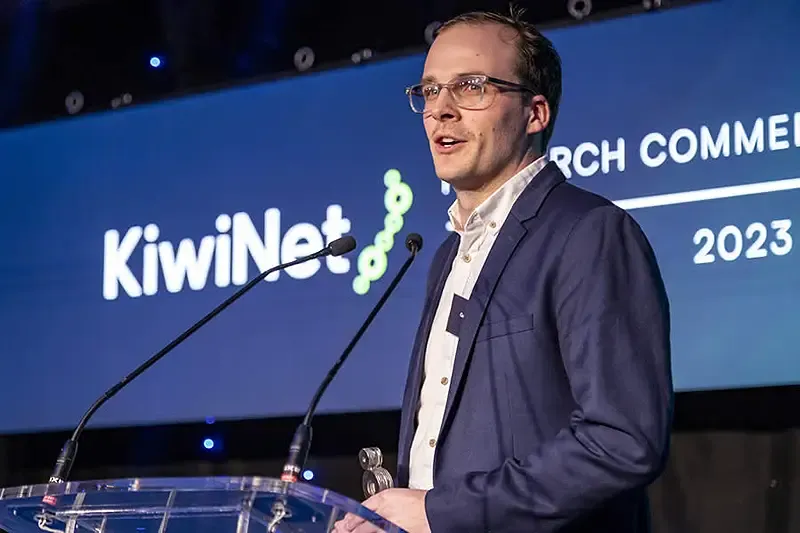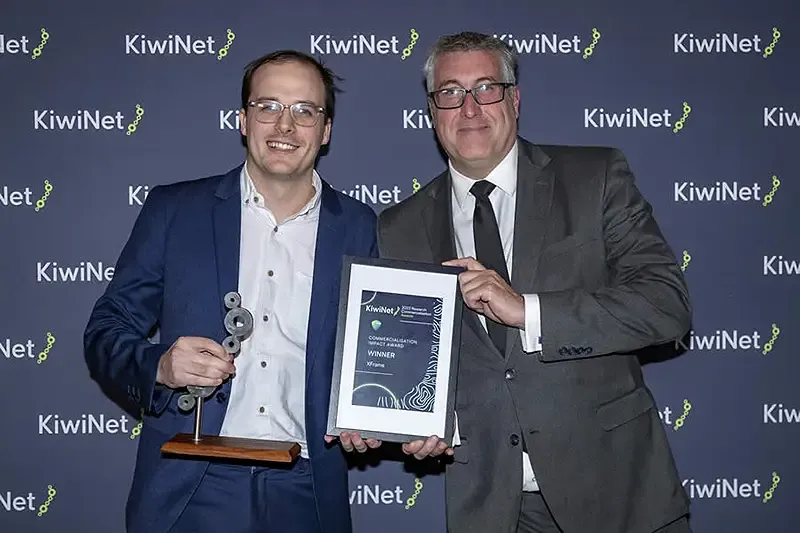Breaking down barriers
By MAS Team
What if the walls around you weren't just static barriers, but dynamic things you could shift, reshape, and adapt according to your needs? What if, instead of becoming timber and plasterboard waste, they had multiple lifecycles beyond their first use? Wellington company XFrame is making these things possible and recently won the MAS Commercialisation Impact Award at the KiwiNet Awards.
Ged Finch is transforming how we construct, use and repurpose the very foundations of our built environments.
He is the founder and CTO of XFrame, a sustainable construction technology company that makes modular demountable walls. In layman's terms, these are walls that can be easily put up, taken down, and used over and over again in different configurations.
This makes XFrame a circular building system, rather than a product. Every element, from the framing to the reversible linings, is designed with reuse and waste minimisation in mind.
It’s a revolutionary idea for an industry that, in Ged’s own words, is conservative, slow to move and quick to reject change. But with multiple awards under his belt and construction heavyweights starting to take notice, it appears that history is moving Ged’s way.

Growing up in the Central Otago town of Omakau, Ged had never anticipated a career in construction. Instead, he spent his free time building dioramas and miniatures, with thoughts of joining New Zealand’s screen industry.
“The dream was to come to Wellington, do an architecture degree and get a job at Wētā Workshop. But as I got further into my architecture study I realised I enjoyed it, I was good at it, and I understood the technical side of construction well,” Ged says.
While conducting research for his thesis, Ged became interested in circular economies and architecture, as well as building methods that use fewer materials and produce less waste.
He began prototyping designs of his demountable wall system, and with a grant from the New Zealand Institute of Building, showcased the first full-scale demonstration of the technology in 2017.
Ged says the reaction to this demonstration gave him the confidence that he was on to a winning idea.
“People were like ‘this is buildable, this can actually work’. This was when I realised it was more than just a demonstration. It was a system with real potential that we could scale up.”
Backed by Victoria University, KiwiNet (a consortium of public research organisations focussed on commercialisation) and a number of New Zealand construction firms, XFrame began the journey to becoming a commercially viable proposition.
In 2019, Ged partnered with Wellington University Ventures and Innovyz, an Australian firm that accelerates the commercialisation of innovative technologies, to establish a foothold across the Tasman and begin exploring other overseas markets.
“Innovyz added a general manager who was dedicated to the company, which helped to create a strong foundation for growth. They've been extremely useful and the university has been really supportive, KiwiNet has been awesome, and everyone has been great to work with.”
As the company has developed, Ged has refined its value proposition, including where the technology works best and where its application is more limited. One example of the latter is the residential construction sector, where price sensitivity means the cheapest building methods are almost always used.
“When you’re spending hundreds of thousands on a build, you’re going to be acutely aware of your budget and it's unlikely you’ll fork out a premium for something like demountable walls,” Ged says.
The same goes for external walls. While XFrame is suitable for load-bearing construction, external walls typically have a lifespan of more than 50 years, meaning they don’t change frequently enough to justify the cost of a system designed for flexibility.
Instead, the company remains laser-focused on owning the demountable office and retail fitout market. Ged says it’s a market subsection worth $40 million in New Zealand alone, and the company is already working with a number of large clients in areas such as banking, energy and co-working.

One factor helping to drive demand for XFrame is an increase in circular economy mandates among large corporates. This means, for example, that a bank looking to renovate its branches will need to adopt sustainable practices that minimise waste and make the most of resource
“What we’re starting to see is the mandate being specified more and more across government and large organisations. This is particularly evident in places like Canada and Europe, where regulations promoting circular practices are much more developed,” Ged says.
And unlike some of its competitors in Europe and North America which use demountable steel framing in their technologies, XFrame’s use of plywood comes with superior carbon advantages.
“So we’re saving carbon upfront, and once people reuse the framing, the carbon is sequestered so the environmental benefits are multiplied,” Ged says.
Given that half of all New Zealand’s waste (around 1.6 million tonnes every year) is generated annually by the construction sector, Ged has his work cut out for him. But he’s made a good start - in its first year of public sales alone, XFrame kept six tonnes of construction waste out of landfills and sequestered 35 tonnes of Co2e.
In addition to saving carbon, XFrame also offers greater speed of installation compared to using conventional materials. Ged says this creates a better experience for the builder and property owner with less disruption and cleanup required.
“It’s particularly evident in countries like Australia where building consents are privatised and usually issued within 24 hours. This means you can get your approval and start installation the next day,” Ged says.
Unsurprisingly, Ged is excited about the future, despite acknowledging the challenges of doing business in the construction industry.
“It can be unpredictable. You might get several months of profitability, and then projects might fall through. The engineering challenges we face can also be colossal,” Ged says.
Despite these challenges, the company has continued to pick up accolades. It recently took out the MAS Commercialisation Impact Award at the 2023 KiwiNet Research Commercialisation Awards and has been named a finalist for the 2023 Earthshot Prize.
“The chance of winning Earthshot is one in a million, but being in the running shows that we’re ticking all the right boxes for that level of investment,” Ged says.
And regardless of whether XFrame takes out the prize, Ged says there’s always an incentive for him to keep going.
“It’s the fact that you know you have a good product, and you know you have a team that’s committed to doing the right thing, in our case, promoting circular economy solutions.
“Whether we achieve that through XFrame or another approach, the mission of the company is solid,” Ged says.

Meet MAS Here for Good Scholarship recipient, Olivia Gray, who details her volunteer activity and the reward of giving the gift of time.

MAS is talking to Members about how COVID-19 has changed their work/life balance. First up is Christine Coulter from Team Medical in Paraparaumu.

The Christchurch mosque attacks have inspired two Afghan-Kiwis to help others.